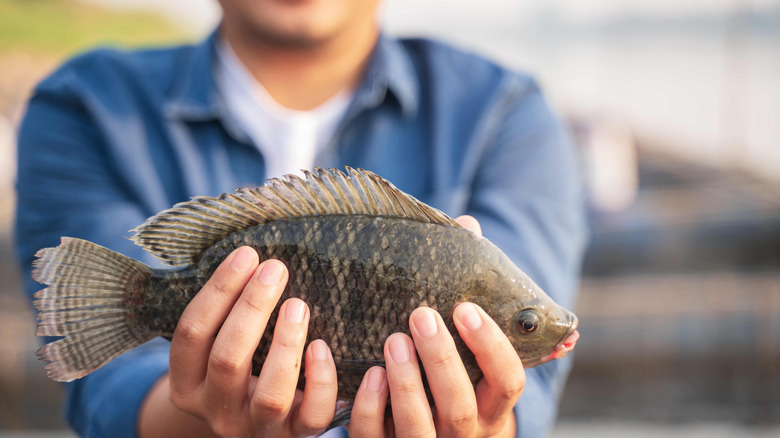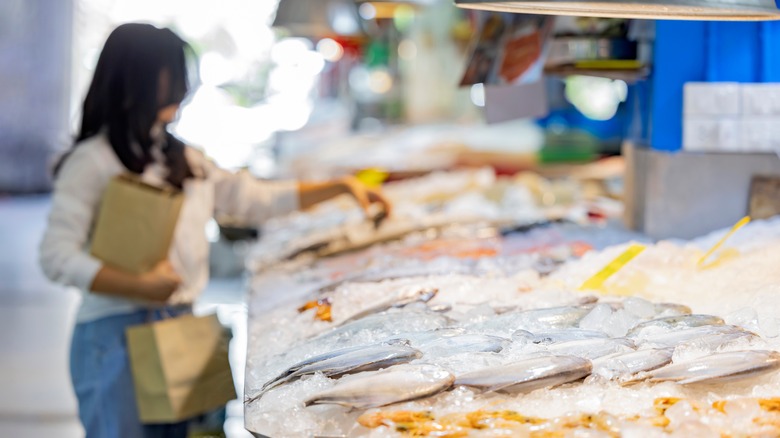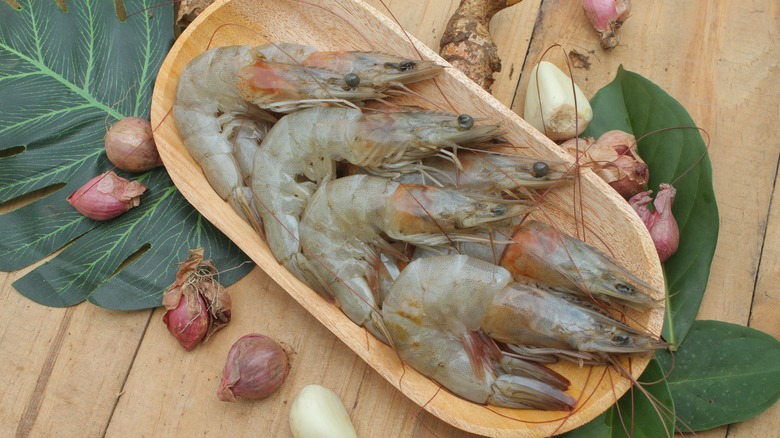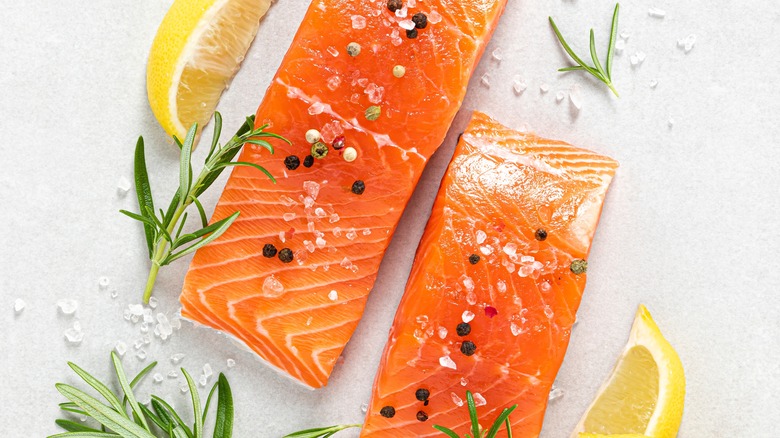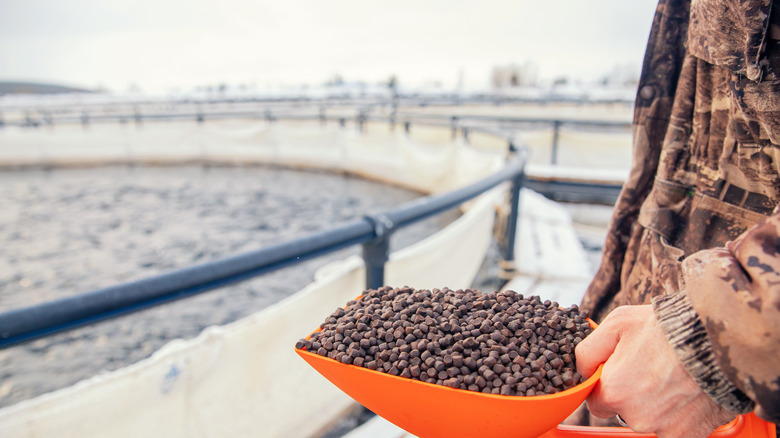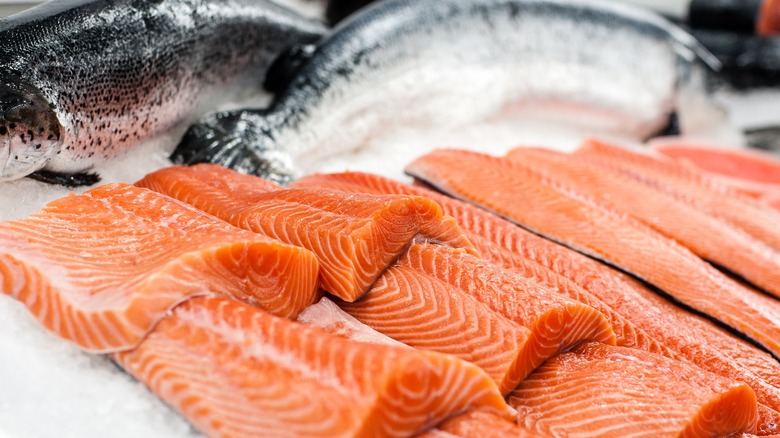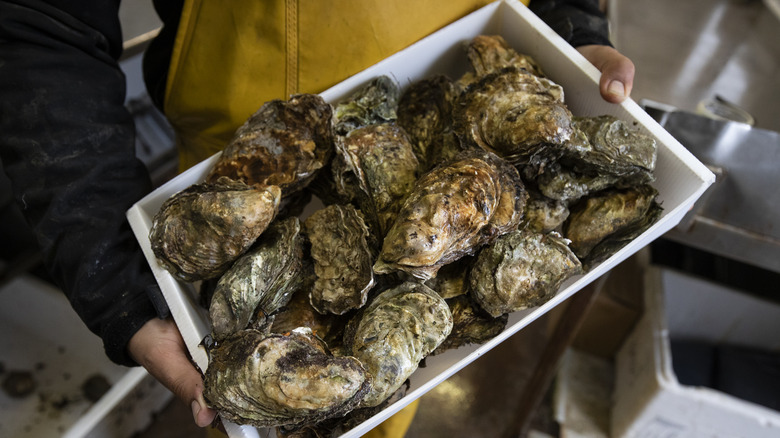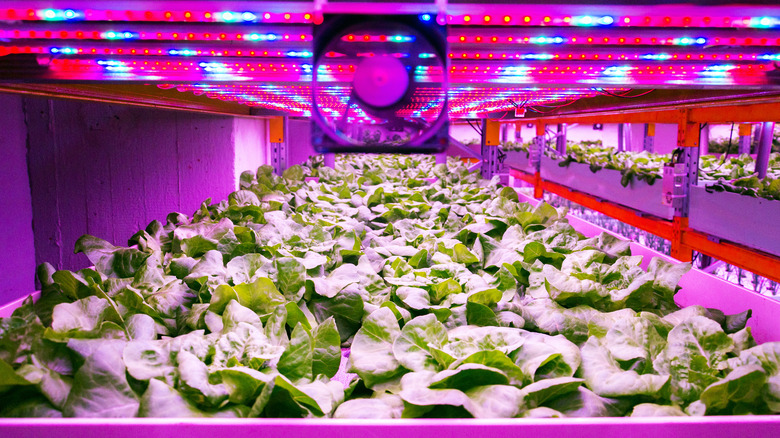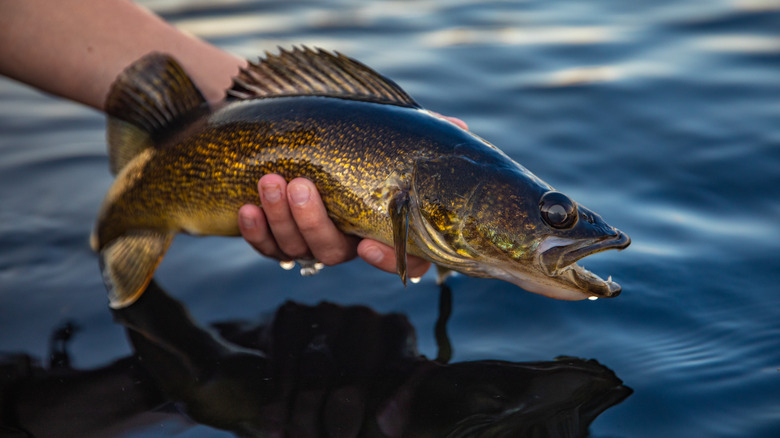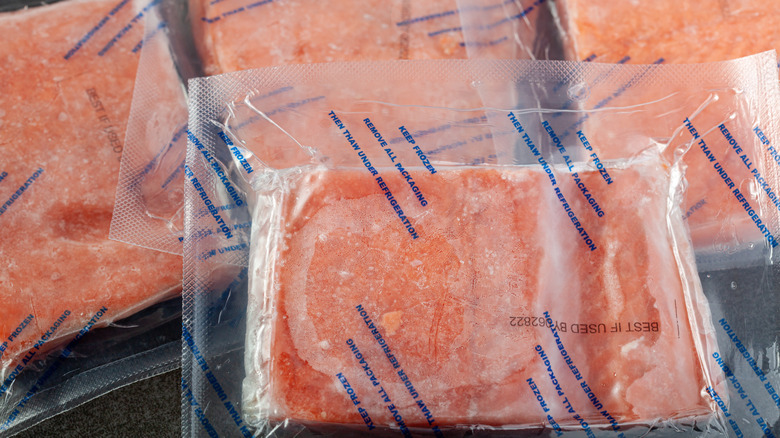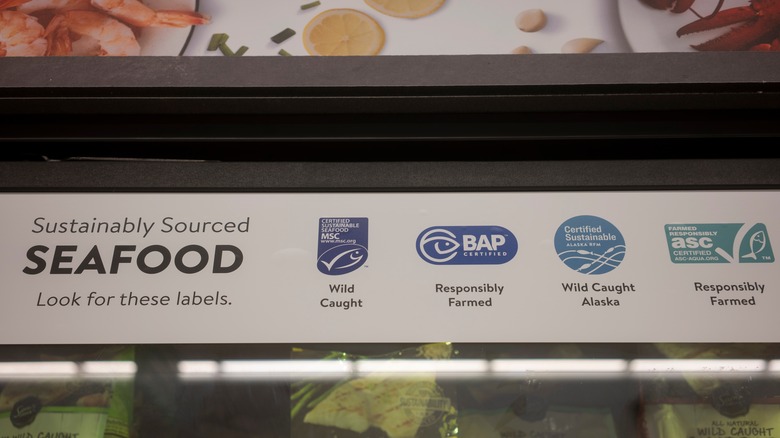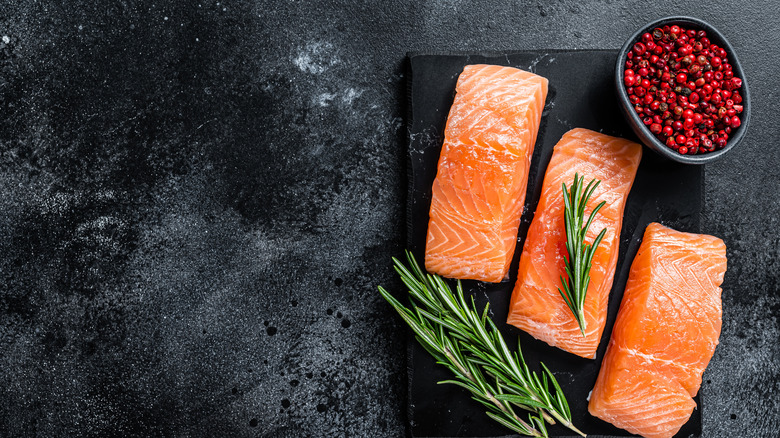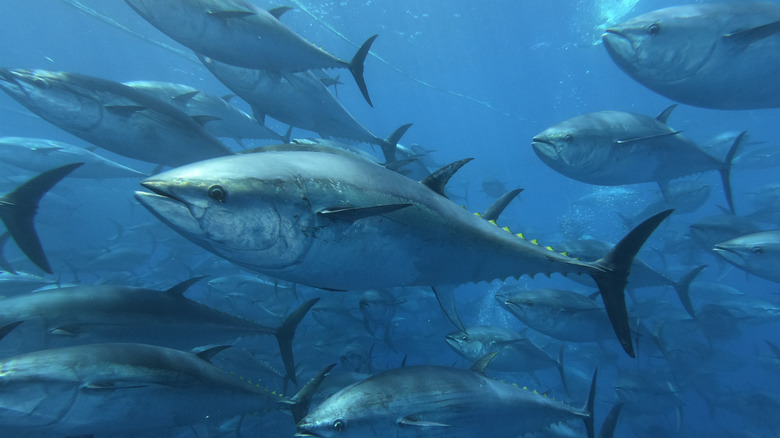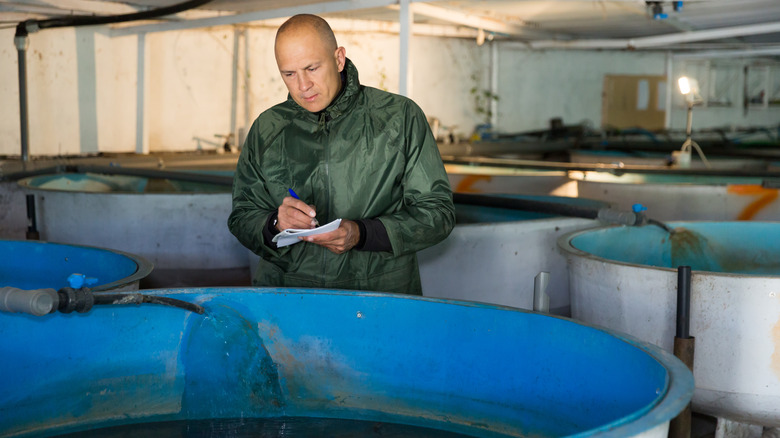15 Things You Need To Know About Farmed Fish
Fish farming, otherwise known as aquaculture, is one agricultural sector that has seen unprecedented growth globally and domestically. According to data collected by the Food and Agriculture Organization of the U.N. (FAO), global aquaculture production has increased by 527% between 1990 and 2018, with roughly half of the seafood imported to the United States being farmed (via the National Oceanic and Atmospheric Administration). Countries like China have seen the most prolific uptick in production, and as of 2013, more fish is farmed than is captured in the wild (per Our World In Data).
Aquaculture is not immune to consumer questions surrounding its practices and ethical complications — especially because of its sheer prevalence at grocery stores and fishmongers. But what exactly does it mean for a fish to be farm-raised, and why does your choice to purchase this growing method over wild-caught seafood matter? We're here to investigate some of the mysteries surrounding aquacultured fish and some of the benefits and drawbacks of choosing farm-raised during your next trip to the seafood counter.
Farmed fish can be more affordable than wild-caught fish
You should check out farmed seafood if you like discounts at the store. Farmed fish is often a more affordable option for seafood lovers because the cost of harvesting, processing, and shipping is lower than wild-caught fish.
There are many options for aquacultured products that don't break the bank — and you'll still get a flavorful, fresh filet. The main difference between farmed and wild catfish, for example, is that farmed catfish has a much cleaner flavor. And at around $1.98 to $2.19 per pound wholesale, farmed catfish is one of the cheapest seafood options you can purchase. Farm-raised Nile Tilapia is another unique, versatile protein with a mild flavor that some would describe as less "dirty" than wild-caught members of the same species.
If you want a more gourmet farm-raised fish that goes heavy on the tastebuds and light on the pockets, check out farm-raised dorade. It tastes similar to a red snapper but goes for only around $10 per pound.
Fish farming includes crustaceans and shellfish, too
While finfish (like salmon, tilapia, and catfish) encompass most aquaculture in the United States, farmed crustaceans and shellfish are also significant contributors to the domestic aquaculture economy. For example, freshwater crawfish are grown in the southern United States and often share rice paddies or wetlands with other agricultural operations. Manilla clams and mussels on grown in off-shore operations on the West Coast and hard-shelled clams are farmed on the East Coast.
Shrimp encompass ⅓ of aquacultural imports to the United States, with the top exporting countries being Thailand, Ecuador, Mexico, China, and Indonesia (via the United States Department of Agriculture). Shrimp aquaculture has trended upwards in recent years; the National Fisheries Institute's Global Seafood Market Conference's panel expected shrimp yield to be over five million megatons annually as of 2022 (via Seafood Source).
Edible fish is a large subsection of the aquaculture industry, but there are other uses for farm-raised fish. For example, saltwater ornamental species, like clownfish, are added to fish tanks, while some trout species are grown in hatcheries to restock rivers for recreational fishermen. Research species, like zebrafish, are a small sector of aquaculture as well.
Farm-raised fish have more omega-3 fatty acids than wild-caught fish
Farm-raised fish may have some nutritional benefits, most notably in the omega-3 fatty acid department. Omega-3 fatty acids are introduced to the animals via their diets. Wild-caught fish eat plankton or algae, while farm-raised fish are fed a processed diet derived from fishmeal, plants, and algae. Since greater control is exerted on the diet of farm-raised fish, producers can maximize the amount of omega-3 fatty acids in the fish. Therefore, the fatty acid levels in farm-raised fish are matched, or even more than those of the wild-caught variety.
Omega-3 fatty acids are important in preventing heart disease and stroke, as well as in building cell membranes in the body. A majority of adults should eat at least 8 ounces of fish each week for optimal heart health. Farm-raised salmon or trout are some of the best sources of omega-3 fatty acids.
Farm-raised fish are some of the most sustainable sources of protein on the planet
There are many reasons why aquacultured fish are touted as a "sustainable" protein source. First, fish have a comparatively low feed conversion ratio, the amount of feed needed to produce a pound of body mass. Aquacultured fish's average feed conversion ratio is around 1.1-to-1, while the average for chicken, beef, and pork is anywhere from 2.1-to-10 (via Global Seafood). In recent years, there has also been a movement to use trimmings from processing plants and plant proteins to help support the demand for farm-raised fish. Fish also do not require the same amount of space as terrestrial livestock, meaning that fish can be grown in indoor recirculating systems or on marginal land where other agricultural activities cannot occur.
Many innovations can be made to help offset some of the environmental impacts of growing finfish, most notably waste. For example, farmers can grow species like seaweed to help soak up the extra nutrients in the water in a polyculture system.
It is heavily regulated for consumer safety
There are always consumer questions about the safety of foods imported to the United States or grown domestically. Aquacultured seafood must pass through the same regulatory procedures as other agricultural goods. These include rigorous food safety, critical control point testing and documentation, and tests for adulteration and import regulations for seafood entering the United States. The National Shellfish Sanitation Program (NSSP), in collaboration with the Food and Drug Administration (FDA), regulates the food safety risks associated with bivalve production, including clams, mussels, and scallops.
A big question that comes up with farm-raised fish is on antibiotics. Like terrestrial farming, all antibiotics given to fish must be approved by the FDA, and any fish imported for consumption in the United States must adhere to these standards. And since aquaculture is a form of agriculture, there is always the risk of antibiotic transfer into the environment. This isn't to say that aquaculture is "dirty" or the fish are continuously pumped full of antibiotics, but rather that using antibiotics in the entire agricultural industry is an issue to people's and the ecosystem's health. Proper farming practices, including reasonable densities and preventative disease management, are two of the best options for counteracting the use of antibiotics.
There are nutritional differences between wild and farmed fish
Farmed fish isn't much healthier than wild-caught seafood. Besides the marginal differences in omega-3s, consumers can rest assured knowing they purchase nutritious fish, whether farm-raised or wild-caught. The protein and micronutrient levels of the two are very similar, with only a slight difference in the prevalence of fats. A 3-ounce filet of wild salmon has about half the fat and fewer calories than farmed salmon. Wild-caught fish also tend to be leaner in texture and lower in fat because they swim longer distances and can go without food during migrations or spawns.
One of the myths associated with fish is that the color directly reflects the fish's nutritional content. The color of the fish's flesh is controlled by two factors; myoglobin and diet. Myoglobin is responsible for storing oxygen in a fish's muscles. Red-fleshed fish, like tuna, snapper, and mahi mahi, have darker meat, while fish like tilapia and flounder are white because the latter move less. Fish that eat darker-colored food, like krill and shrimp, will have redder flesh. Since farm-raised fish do not have these crustaceans in their diet, the color of their meat is typically paler.
Shellfish aquaculture has the potential to reduce negative environmental impacts
Shellfish aquaculture has its own set of environmental benefits because these organisms are bivalves. Bivalves, which include clams, scallops, and oysters, do not require any supplemental feed, nutrients, or chemicals to grow. Instead, filter feeders take in nutrients from their immediate environment, including fertilizer runoff from local farms, lawns, and cities. As a result, bivalves have a negligible impact on the environment because they gobble up these fertilizers, which would otherwise cause algae blooms and subsequent oxygen depletion in waterways.
In addition, these organisms take carbon in from the atmosphere, which can aid in ameliorating climate change. For example, beef farming produces 340 tonnes of greenhouse gases per tonne of edible beef, compared to bivalve production at 11 tonnes, per a study. Bivalve cultivation has positive benefits for the structure of the ecosystem, too. Oysters are considered ecosystem engineers because they build new reef habitats for other bivalves, finfish, and algae.
There's the potential to grow more than just protein from fish
If you've ever eaten hydroponic lettuce, you've already tasted what else aquaculture can produce. Hydroponics, produce grown without traditional growth media like soil, is a valuable method of growing food to reduce the need for terrestrial space. Aquaponics is similar to hydroponics but is powered by the nutrients derived from fish waste. An entire aquaponics system can produce vegetables, like lettuce, radishes, and berries, and protein from fish. Aquaponics can be grown in numerous ways, including vertical farming, which uses gravity to move nutrient-rich water from one place to another.
Aquaponics is less common than hydroponically-grown produce because of the project's high capital investment and the knowledge needed to set up and manage an aquaponics system. Several communities around the United States have expressed interest in developing these aquaponic systems to utilize reclaimed land and create jobs (and food) for their residents — which is expected to help push aquaponics to flourish in coming years.
Aquaculture is one tool to curb overfishing
One of the most immediate environmental benefits of eating aquacultured fish over wild-caught fish is the reduction of dependence on wild fish populations. Besides depleting wild stocks, wild-caught fisheries also have several issues with illegal catching and poaching of species, catching species of fish not initially intended (bycatch), and human rights violations. The FAO estimates 34.2% of the world's fisheries are considered overfished, meaning that the population is below an optimal level for maximizing harvest (via the University of Washington). Below-optimal fish populations have reverberating impact on the food chain and the supply-and-demand of the fisheries, livelihoods, and eaters that depend on the fish stocks to survive.
While some fisheries, like the tuna industry, have shifted toward more sustainable fishing methods, not all fisheries have made the same drastic efforts to curb overfishing. While there are environmental drawbacks to choosing farmed fish over wild-caught, the issue of overfishing poses a glaring contrast.
You can't find organic-certified farmed seafood
If you frequently purchase organic food at your grocery store, you may wonder why you can never find organic seafood. Wild-caught food cannot be considered organic because there is no control over what the fish eat and what kind of toxins they're exposed to. But since farmed seafood has a bit more human intervention, can't it be certified under the USDA's organic program?
There is currently no legislation or process for organic certification under the USDA's Organic Foods Production Act. In turn, this means that the USDA cannot seek legal penalties against any producer who markets their farm-raised (or wild-caught) fish as "organic." Yet, some companies still market their fish as "organic" because of the regulatory loophole. Several grocers like Whole Foods Market and governments like the state of California refuse to sell fish labeled as "organic." However, others, like Wegman's, have permitted the sale of "organic" marketed fish under European Union or Canadian organic certifications.
There are many certification programs that can indicate when farmed seafood is a good choice
Certification programs like USDA Organic and Fair Trade help aid in the transparency and marketing of food products as sustainable. There are many of these certifications exclusive to seafood, and they can help consumers decipher when to choose wild-caught or farm-raised seafood. The Monterey Bay Aquarium's Seafood Watch is one certification that both sets advisory standards for certain types of seafood, as well as certifies operations for environmental sustainability and social responsibility.
Another notable certifying body is the Aquaculture Stewardship Council (ASC). This third party certifies exclusively farm-raised fish for ecological and social sustainability. Some of the council's standards include optimizing sustainable feed, prohibiting the use of prophylactic (preventative) antibiotics, requiring regular testing for certain diseases, and ensuring limitations on stocking density to promote animal welfare. Look for the teal ASC label if you're purchasing farm-raised seafood from your local purveyors.
Farmed fish and wild-caught fish may be cooked differently
Seafood snobs may say they "always prefer the taste of wild-caught fish" over the taste of farm-raised fish. Unfortunately, there is no "right answer" for which type of fish is superior, and the answer depends entirely on consumer preference. It also depends on the diet and habits of the fish in question.
Take salmon, for example. Farm-raised salmon is fattier in texture and milder in flavor because the fish is fed a formulated feed regimen. Since it has a higher fat content, this makes salmon a little more forgiving than wild-caught salmon when it comes to cooking. It is harder to overcook because it contains more fat, which makes it better for high-heat cooking than wild-caught salmon. If you're cooking wild-caught fish, avoid cooking it past medium rare. Otherwise, you'll dry the fish out quickly and cause it to become chalky.
Farmed fish can be sushi-grade
In some instances, farm-raised fish is more optimal than wild-caught — salmon for sushi is one of them. Wild salmon, which can eat parasite-infested prey, are at higher risk for parasites than aquacultured salmon, which are fed a pelleted feed.
This isn't to say that wild-caught fish aren't able to be eaten for sushi. In fact, many of the species we often associate with sushi, like an eel, cannot be farmed because of their lifestyle or reproductive habits. Large species of tuna are deemed safe for sushi and sashimi by the Food and Drug Administration because of the low instances of parasite infection recorded in history and how frequently they are eaten. This is also not to say that you can't sushi made with other types of fish. Some species used for sushi must be frozen below a specific temperature, which can be as low as -31 degrees Fahrenheit, to kill off any lingering parasites. Since home freezers don't get this low in temperature, it is recommended that home cooks buy from a reputable sushi restaurant rather than buy a filet of any fish and make their own sushi at home.
Aquacultured fish are not immune to contaminants
Large, predatory fish like tuna and swordfish are often associated with heavy metal accumulation, like mercury. Heavy metals are most likely to be found in these fish species, many of which cannot be grown in farmed conditions because the toxins bioaccumulate throughout the food chain. Both farmed and wild fish can be exposed to mercury because of industrial pollution in lakes, rivers, and other waterways where the fish are farmed or live. Still, the risk is minimal compared to the consumption of large predatory species (via Colorado State University). In addition, early studies of farmed salmon showed higher rates of polychlorinated biphenyls (PCBs) compared to wild-caught salmon, but follow-up studies have not confirmed this differential, notes the Washington State Department of Health.
One emerging issue within farmed fish is the ingestion of microplastics from fishmeal. The human health impact of ingesting these microplastics via farm-raised fish is unknown but potentially nulled by the phasing out of fishmeal in favor of plant-based fish feeds (per Environmental Health News). That being said, there is also little research to indicate that there is a tangible difference between the number of microplastics consumed by wild versus farm-raised fish.
Farmed fish is shrouded in misinformation
There is a ton of misinformation out there about agriculture — including fish farms. Stories about fish escaping their enclosures and breeding with wild-caught fish, along with images of fish packed like literal sardines into sea nets, have discouraged many consumers from eating farm-raised fish. That's not to say that high stocking densities and escapees don't happen in the aquaculture world, but the increasing web of knowledge about sustainable growing practices and disease, combined with financial incentives to help producers adopt more sustainable practices, is shifting the dynamic about how we talk about aquaculture.
When discussing vilified industries, whether it be agriculture or aquaculture, consumers have to think about where the information is coming from and what it's trying to tell them. Like any food production method, there are drawbacks — as well as over-dramatizations — that destroy livelihoods and curb the growth of innovations in the industries like aquaculture. We recommend making informed choices regarding whether you purchase wild or farmed fish.
